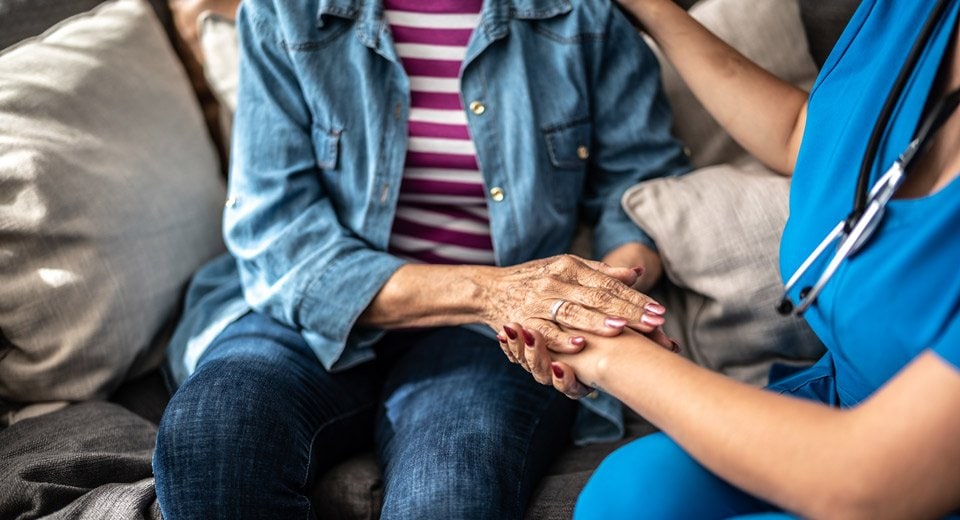10 common hospice myths

Hospice care provides physical comfort, emotional support and spiritual support to those who are nearing the end of their life. The goal of hospice is to allow people to live with comfort and dignity and feel supported as they prepare for death in their own way. Hospice workers do that by helping patients manage symptoms, so they can spend their last days doing what is important to them.
Even though most people have heard the word “hospice,” there are a lot of myths about what it is – and isn’t. We asked Sharon Molinaro, RN, CHPCA, executive director of hospice operations for the Visiting Nurse Association and McCarthy Care Center to talk about the 10 most common hospice care myths.
VNA of Cape Cod Hospice & Palliative Care offers support to patients and their families and caregivers when a life-limiting illness is no longer responding to curative treatments. Services can be provided in a home setting, an assisted or independent living facility, a skilled nursing facility or a short-term, acute inpatient hospice care setting, like McCarthy Care Center in Sandwich.
Myth: Hospice is a place.
Fact: “Hospice is a support service and is provided wherever the patient resides,” Molinaro said. “It does not include 24-hour in person care, but it does offer 24-hour support.”
McCarthy Care Center, a VNA of Cape Cod hospice facility, offers an acute level of care for our VNA hospice patients. It is located in East Sandwich and provides 24-hour medical care for hospice patients who are experiencing symptoms that cannot be managed in a home setting.
Myth: When you sign up for hospice, someone will come and stay with you.
Fact: Hospice is not a primary caregiver service and does not include constant monitoring of the patient in the home. “That’s probably the biggest misconception,” she said. The hospice team visits on a regular basis and does offer support services to the patient and their family, but does not come and stay long-term. If a patient or family needs that kind of support, hospice can offer a list of resources that may be available for private care on the Cape.
Myth: Hospice is for patients who have no hope or who have given up.
Fact: “Actually, patients sometimes do better on hospice than they do when they’re not receiving hospice services,” Molinaro said. “The choice that they are making is to give up curative treatment, but it doesn’t mean that they are giving up on life. We support them wanting to live their fullest life.”
Providing durable medical equipment is one way that may help hospice patients keep up their endurance. For example, if a patient has a wheelchair, someone can push them, which saves their energy to do something else that they might want to do. An electric bed with rails allows patients to get up and reposition themselves when no one is around to help them and that may help preserve their energy.
“When people have the support services and resources that they need, oftentimes they do better and live longer,” she said.
Myth: If you start hospice, you only have a short time to live.
Fact: “We have patients who have been on hospice for one to two years. Everyone’s disease process is different,” Molinaro said. “When a physician is giving someone the approval (to receive hospice care), they’re saying it’s probable that the patient has six months or less to live.”
Myth: When someone signs up for hospice, they can’t change their mind about getting treatment.
Fact: “When someone signs up for hospice services, they’re not signing up for life,” Molinaro said. “What they are doing is agreeing to do it right now. If someone decides that they want to get curative treatment at some point while they’re on hospice, they just need to sign documents to come off hospice services.”
Myth: Hospice is only for the patient.
Fact: “The VNA Hospice program offers services to the patient and family as needed,” she said. “Throughout hospice care and following the patients passing, both the patient and their loved ones have access to support services, including grief counseling.”
Myth: Hospice is only for cancer patients.
Fact: Anyone, at any age, with a terminal diagnosis or end-stage disease process could be eligible for hospice services. Qualifying terminal diseases could include dementia, COPD, protein calorie malnutrition, end-stage heart disease, end-stage pulmonary disease, kidney or liver failure, stroke or cancer.
Myths: The medications used to treat pain can hasten death.
Fact: “Medications are given for symptom management at end of life and to keep the patient comfortable, not to hasten their death, Molinaro said.
Myth: You must sign DNR (Do Not Resuscitate) paperwork to be admitted to hospice care.
Fact: Primary care providers and hospice providers will talk to patients about a DNR at some point when they think the conversation is important, but that is only so the patient’s wishes can be met.
“We don’t push people into signing a DNR or MOLST form. This is their journey and their decisions to make,” Molinaro said.
Myth: You must pay out of pocket for hospice services.
Fact: The patient’s insurance company decides what is covered for hospice care coverage.
About 80 percent of hospice patients have Medicare, which does cover 100% of hospice-related services and medications. Most private insurance companies also have a hospice benefit. For those who don’t have insurance, medical social workers can help point them in the right direction to find the insurance and care they need.
